Originally posted by Epirot
View Post
Busting the "Vergina Tomb" myth
Collapse
X
-
Do you think if there was, it would be promoted by the jokers that discovered it? I don't. In fact, I think they would probably do everything they could to avoid that particular point altogether.In the name of the blood and the sun, the dagger and the gun, Christ protect this soldier, a lion and a Macedonian.
-
-
Actually the name of this type of burials are "Kurgan". Kurgans believed to be related to the very first known wandering people with Eurasia and Caucus origin.
Also there is a theory based on this pit-grave culture which tries to explain indo-European people;
http://en.wikipedia.org/wiki/Kurgan_hypothesis
Comment
-
-
I have a national geographic magazine from Nov 1912 (pre grkoman occupation) that states that region was settled by Thracians from the East and Illirians from the west.Originally posted by Soldier of Macedon View PostDo you think if there was, it would be promoted by the jokers that discovered it? I don't. In fact, I think they would probably do everything they could to avoid that particular point altogether.
Ofcourse after new settlment and occupation in that region post 1913, coupled with a heavy dose of media, money and propaganda they are, have and always were greeks !!
Comment
-
-
According to N.G.L Hammond the entire region (including Mt Olympus) was inhabited by Thracians, who he says were natives.Originally posted by Stojacanec View PostI have a national geographic magazine from Nov 1912 (pre grkoman occupation) that states that region was settled by Thracians from the East and Illirians from the west.
Ofcourse after new settlment and occupation in that region post 1913, coupled with a heavy dose of media, money and propaganda they are, have and always were greeks !!
Hammond's thesis is that the Macedonians drove the Thracians out, but I find this incredible to believe.
Comment
-
-
Originally posted by TrueMacedonian on another thread:

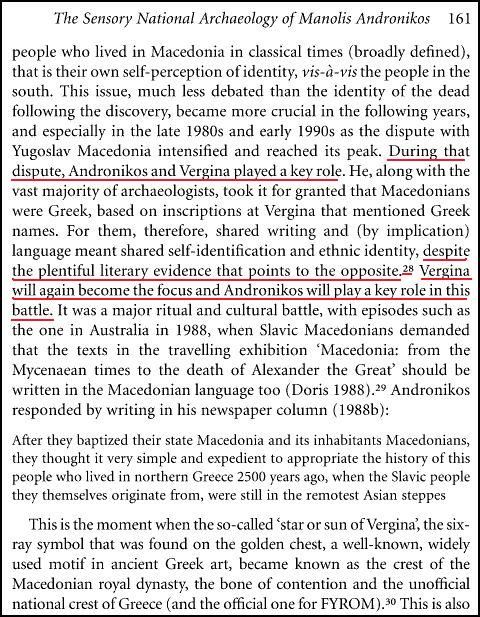

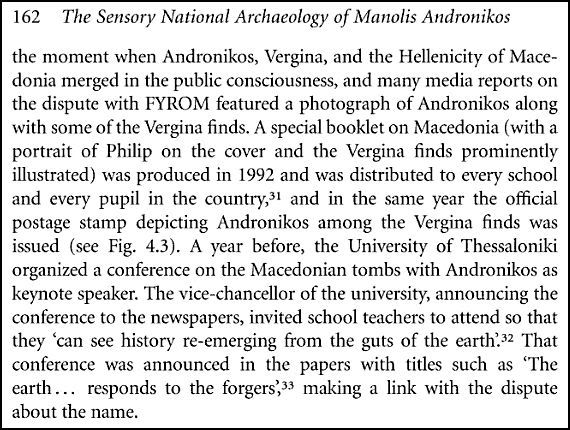
“The nation and its ruins: antiquity, archaeology, and national imagination“
By Yannis HamilakisThe purpose of the media is not to make you to think that the name must be changed, but to get you into debate - what name would suit us! - Bratot
Comment
-
-
The Eye Injury of King Philip II and the Skeletal Evidence from the Royal Tomb II at Vergina
The Royal Tomb II was discovered in Vergina, Greece, in 1977. It contained a male skeleton and a rich array of grave goods. Evidence of trauma supposedly in the orbital bones of the skull has been thought to correspond to an eye injury that King Philip II is historically known to have suffered. However, reexamination of the orbital morphology showed no evidence of such pathology. Therefore, the skeleton does not belong to Philip II. New skeletal evidence shows that the skeleton belongs to King Philip III Arrhidaeus. In this case, the tomb may well contain some of the paraphernalia of Alexander the Great.
Antonis Bartsiokas
Science 21 April 2000:
Vol. 288 no. 5465 pp. 511-514
DOI: 10.1126/science.288.5465.511
 Last edited by Bratot; 05-09-2011, 06:12 AM.The purpose of the media is not to make you to think that the name must be changed, but to get you into debate - what name would suit us! - Bratot
Last edited by Bratot; 05-09-2011, 06:12 AM.The purpose of the media is not to make you to think that the name must be changed, but to get you into debate - what name would suit us! - Bratot
Comment
-
-
Other research made by N.I. Xirotiris and F. Langenscheidt come to the conclusion that the bones, including those of the skull have no trace of injury.

However, more recent paleopathologic reexamination
of the bones 3 using macrophotography with
proper magnification did not provide evidence of
wound injuries, leading to the conclusion that the
bone lesions are simply normal anatomical features
or were due to cremation. This report suggests that
the bones belong to Alexander’s half-brother Philip
III Arrhidaeus, who had ruled for six years after Alexander’s
death and wasmurdered in 317 bce, ahypothesis
which puzzled some archaeologists immediately
after the pronouncement of Andronicos’s theory.23,37
23. Lehmann Williams P: The so-called tomb of Philip II; a different
interpretation. Am J Archaeol 84:527–31, 1980
37. Xirotiris NI, Langenscheidt F: The cremations from the Royal
Macedonian tombs of Vergina. Achaeological Newspaper
1981:142–60, 1983Last edited by Bratot; 05-09-2011, 06:15 AM.The purpose of the media is not to make you to think that the name must be changed, but to get you into debate - what name would suit us! - Bratot
Comment
-
-
Here's the abstract from the latest study of this "problem" :
Inscribed Silver Plate from Tomb II at Vergina: Chronological Implications
Five items of silver plate from tomb II at Vergina are inscribed with their ancient weights. The inscriptions, using the acrophonic and alphabetic systems, suggest that the pieces were made to a drachma weight of ca. 4.2 g. This weight of drachma was introduced to Macedonia by Alexander the Great and does not appear to have been used by Philip II. The inscriptions on the silver add to the cumulative evidence provided by the cremated remains, black-gloss saltcellars, and iconography of the lion-hunt frieze that tomb II was the final resting place not of Philip II, but of Philip III Arrhidaios and Adea Eurydike
Author(s): David W. J. Gill 1
1Swansea University, centre for egyptology and mediterranean archaeology, school of humanities, singleton park, swansea, wales sa2 8pp, united kingdom.
The purpose of the media is not to make you to think that the name must be changed, but to get you into debate - what name would suit us! - Bratot
Comment
-
-
As confirmation of the previous indications we are served by the Greek propaganda itself, confirming much of their manipulations and revealing the reasons:
The Burial of the Death (at Vergina) or The Unending Controversy on the Identity of the Occupants of Tomb II
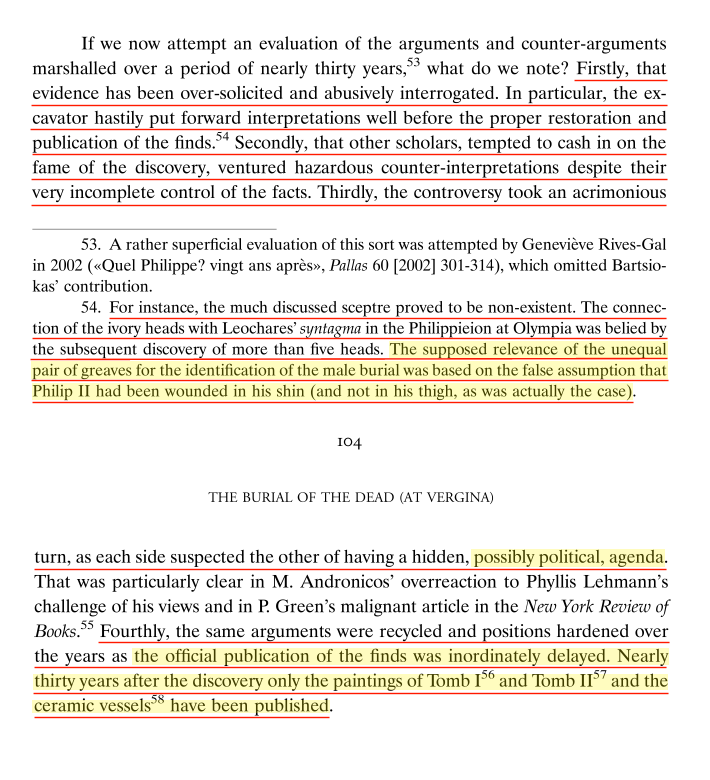 Last edited by Bratot; 05-09-2011, 06:26 AM.The purpose of the media is not to make you to think that the name must be changed, but to get you into debate - what name would suit us! - Bratot
Last edited by Bratot; 05-09-2011, 06:26 AM.The purpose of the media is not to make you to think that the name must be changed, but to get you into debate - what name would suit us! - Bratot
Comment
-
-
It also shows how, in return, national imagination has created and shaped classical antiquities and archaeological practice from the nineteenth century to the present. Yannis Hamilakis covers a diverse range of topics, including the role of antiquities in the foundation of the Greek state in the nineteenth century, the Elgin marbles controversy, the role of archaeology under dictatorial regimes, the use of antiquities in the detention camps of the Greek civil war, and the discovery of the so-called tomb of Philip of Macedonia
The National Imagination in Greece
The Nation and its Ruins Antiquity, Archaeology, and National Imagination in Greece by Yannis Hamilakis http://www.amazon.com/Nation-its-Ruins-Archaeology-Imagination/dp/0199230382#_ Yannis Hamilakis, Senior Lecturer in Archaeology, University of Southampton http://www.southampton.ac.uk/archaeology/indexThe purpose of the media is not to make you to think that the name must be changed, but to get you into debate - what name would suit us! - Bratot
Comment
-
-
^ Quite Clear ? And what if it isnt quite clear Daskalot ?
http://www.scribd.com/doc/47364467/J...l-of-Medical-S
The Occupants of Tomb II at Vergina. Why Arrhidaios and Eurydice must be excluded
On 21 April 2000 Science published an article by Antonis Bartsiokas titled ‘The Eye Injury of King Philip II and the Skeletal Evidence from the Royal Tomb II at Vergina’. In it he criticised some observations made by Prag, Neave and Musgrave in earlier publications concerning possible trauma to the cranium and facial asymmetry. In an attempt to identify the man in the main chamber of Tomb II at Vergina as Philip III Arrhidaios rather than Philip II, he also argued that the bones had been burned dry, degreased and unfleshed. We answer his criticisms, and refute his dry cremation argument, pointing out that, far from strengthening the claim for Arrhidaios, it weakens it considerably.
If Bartsiokas is right and the bones in the gold casket were burned dry, they could never have belonged to Philip III Arrhidaios because it would have taken them several years to achieve the state of dry-ness to produce the fracture lines classic of dry cre-mation. The literature on decomposition is extensive.References (18) and (19) are useful sources. This is hypothetical. We have already demonstrated that the bones from the main chamber were burned fleshed. It is also likely that the fleshed body of Arrhidaios was cremated soon after death on ethical grounds. For ordinary Macedonians burying him and exhuming him for cremation and reburial later would have been repugnant. ‘In many ancient Greek sacred laws, every human corpse is considered a significant source of pollution’ (20). See Section 9.1.2. We happen to have a description of the reaction of battle hardened soldiers to rotting corpses at the time. To those beleaguered in Pydna during Cassander’s siege in 316, the sight and stench as recorded by Diodorus Siculus (Library of World History 19.49.4) was abominable and unbearable.
THE CASE FOR ARRHIDAIOS ANDEURYDICE GROWS WEAKER7.1. The absence of Kynna. The argument in favour of Arrhidaios and Eu-rydice as the occupants of Tomb II is further undermined by the absence from Tomb II of the remains of a third person. Both Diodorus Siculus (19.52.5) and Diyllos (29) imply that Kynna, Cleopatra’s mother, wasburied alongside her daughter and son-in-law Arrhidaios. Presumably Kynna’s ashes were already in an urn as she was executed in Asia by Alcetas inc.322BC (8, n.30). See too Section 9.1.2.
We answer Bartsiokas’ criticism of our early work on a very small area on the upper facial skeleton of the man in the main chamber of Tomb II at Vergina.We also maintain that there is ample evidence of asymmetry in the lateral wall of the right maxillarysinus; and of alveolar resorption on the right side ofthe maxilla that may have resulted from periodontaldisease. We have demonstrated that he was mistaken in claiming the skeleton was burnt dry rather than fleshed. He understood the differences in appearance between bones burned fleshed and those burned dry.However he seems not to have understood how long it takes a fleshed cadaver to become a completely dry,degreased skeleton. We have drawn attention to the consequences for the pro-Arrhidaios supporters of this misunderstanding. Finally we do not believe that the qualitative and quantitative differences between the two collections of bones in Tomb II, their committal in separate caskets and chambers, and the absence of a third individual fit the descriptions of the funeral Cassander laid on at Aigai for an undistinguished Argead king, his wife and his mother-in-lawLast edited by Voltron; 05-10-2011, 04:22 AM.
Comment
-
-
Originally posted by Daskalot View PostThank you Bratot, I think it is quite clear that the remains found in the tomb does not belong to Filip II.But I still don't think the title is appropriate and that "TM" and "Bratot" did NOT bust anything because prominent scholars such Eugene Borza and those who aligned with his analysis and published position on the archaeological discoveries have been saying this in published literature for decades. Thus I would say that "TM" and "Bratot" helped to bring some information to the notice of uninformed MTO forum readers (i.e. shedding some light on the topic of the Macedonian Royal Tombs at Kutlesh, aka "Vergina"!) and nothing more, which is a good thing in any case but is far from "busting a myth".Busting the "Vergina Tomb" myth
Comment
-

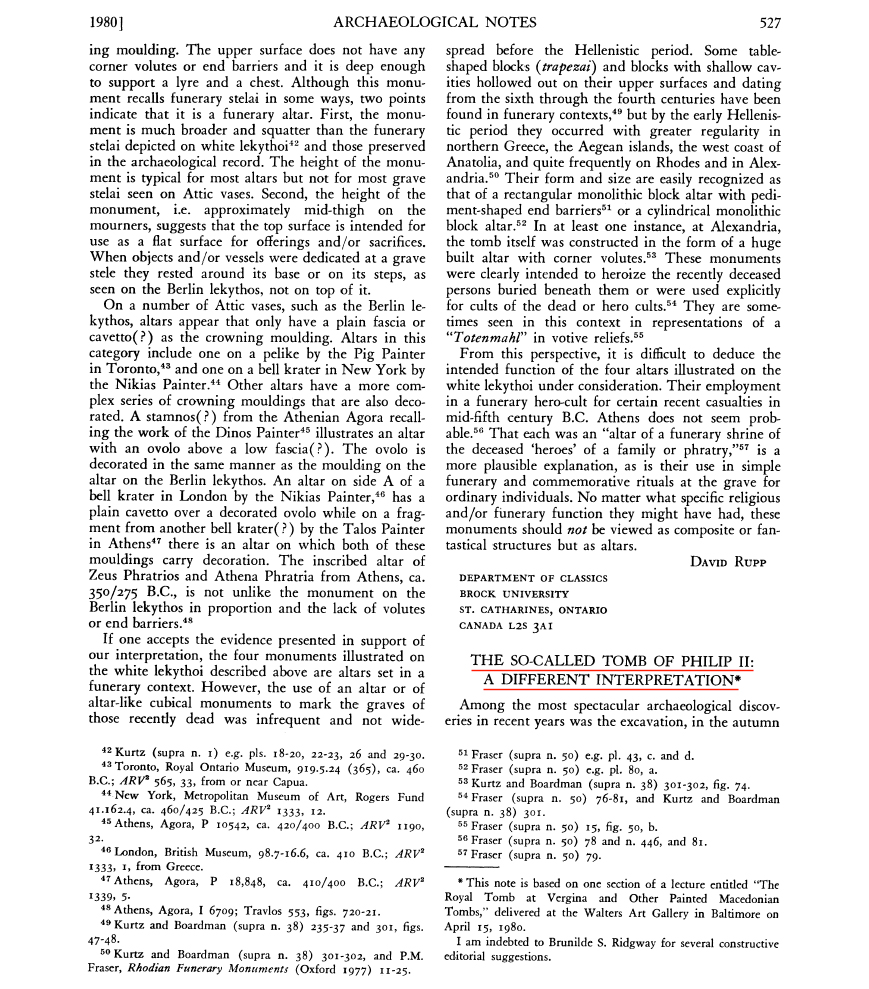

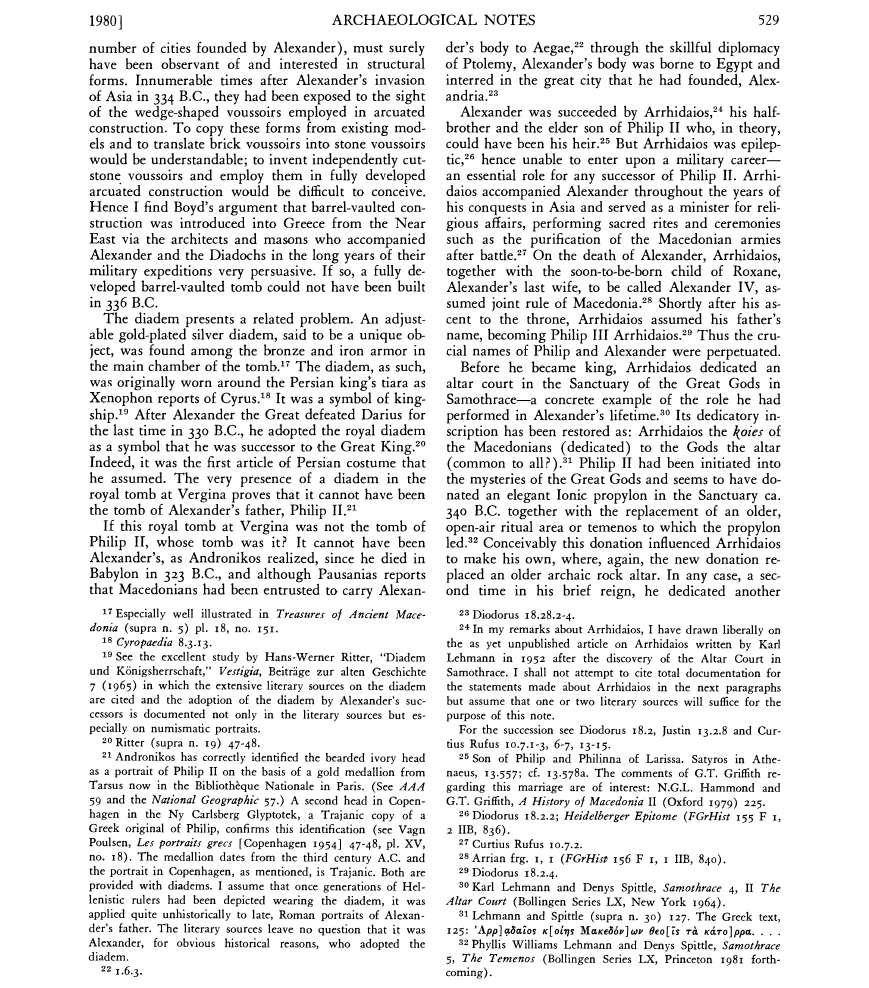
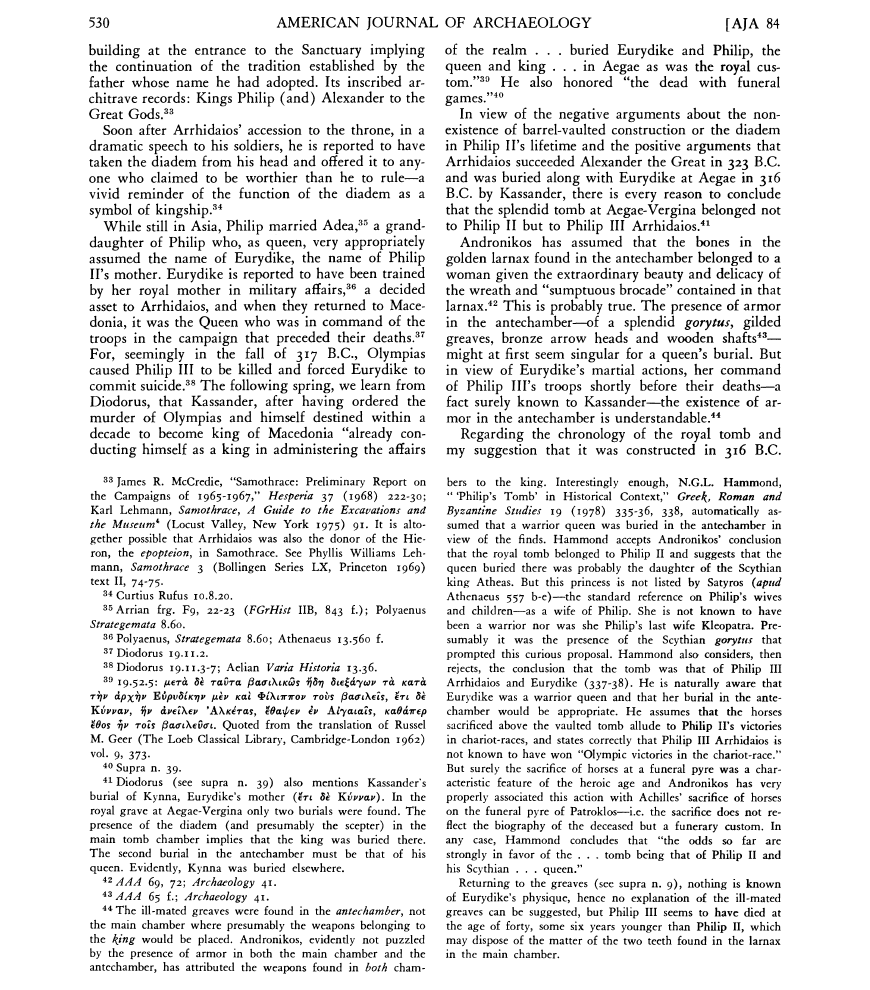
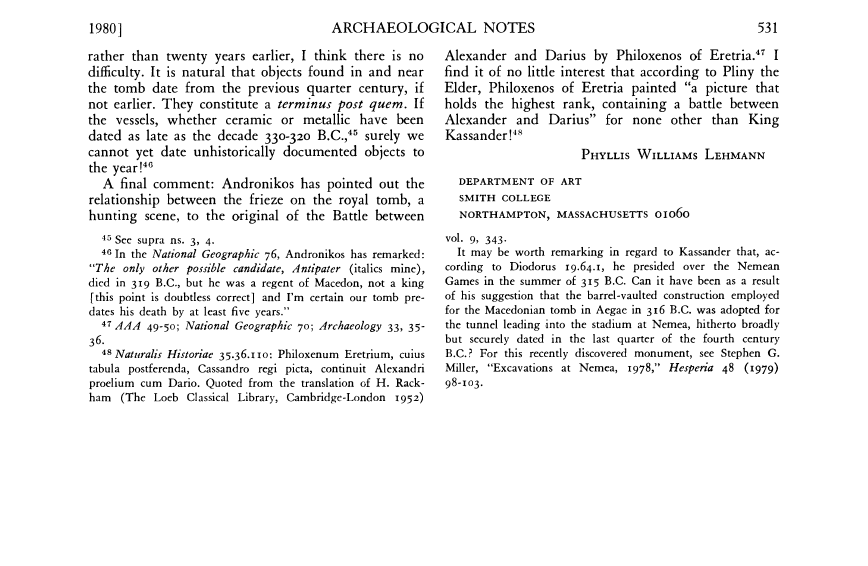
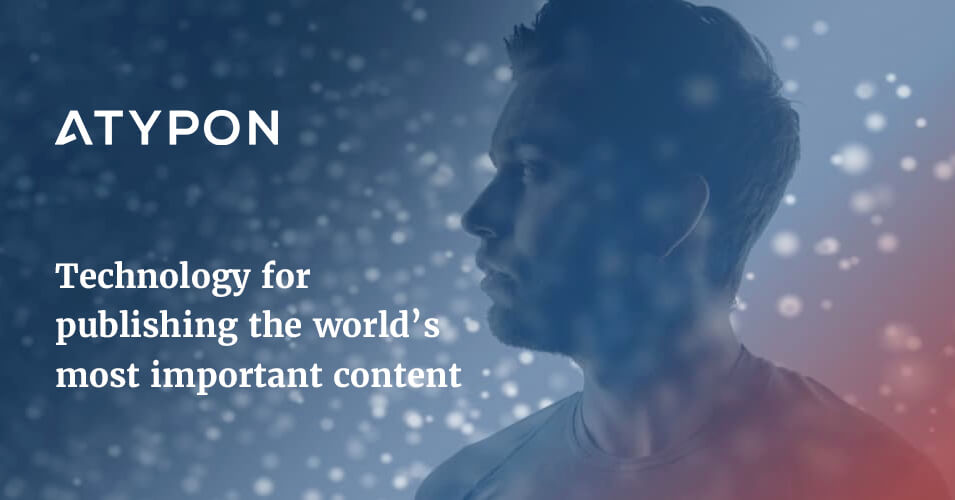
Comment